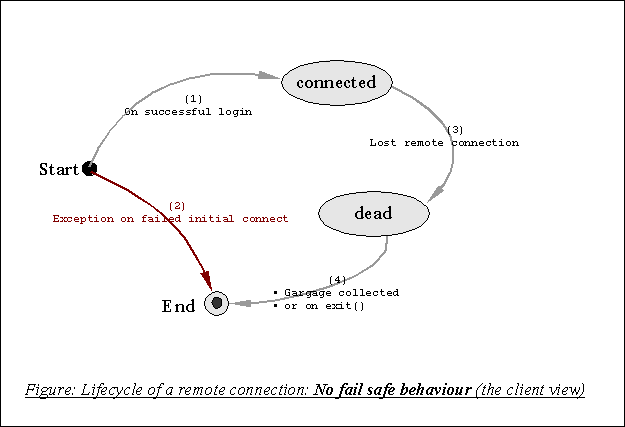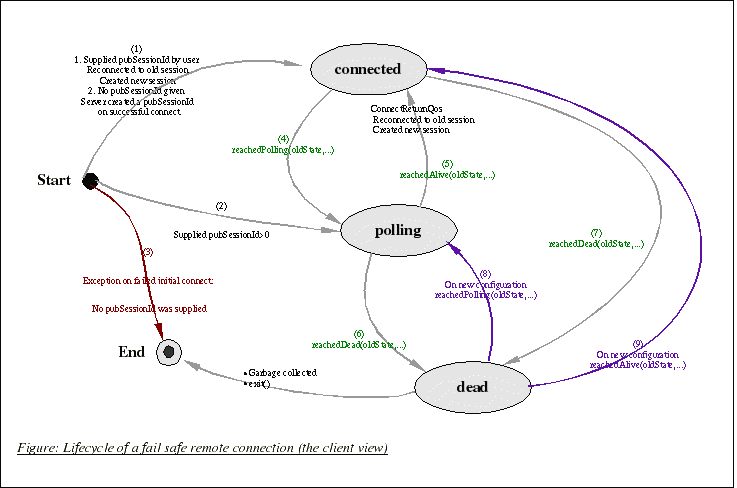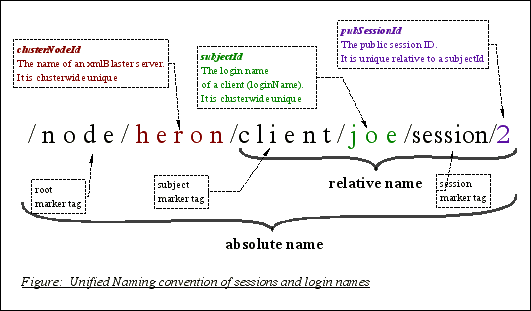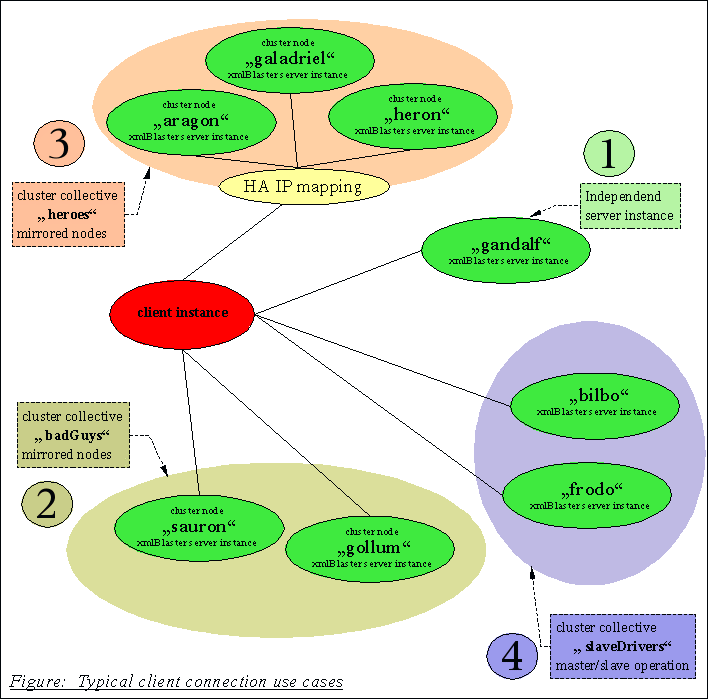REQUIREMENT
client.failsafe
|
REQUIREMENT client.failsafe |
| Type | NEW |
| Priority | HIGH |
| Status | CLOSED |
| Topic | I_XmlBlasterAccess is the Java client side interface to xmlBlaster which supports polling for xmlBlaster and record/playback of messages during lost connections. | |||||||||||||||||||||||||||||||||||||||||||||
|
Des cription |
We discuss in this requirements the strategy used by clients to connect to an xmlBlaster server. The same strategy is used by an xmlBlaster server to callback to a client. Standard client connection Lets have a look at the states of a client connection without any fail-safe behaviour: 
On startup a client tries to connect to xmlBlaster and if xmlBlaster is not found we get an exception. Every client developer needs to code her own strategy how to poll for xmlBlaster in such a case. Fail save mode In fail-safe mode the status diagram of a client connection (and similar a callback connection in xmlBlaster) is a bit more complicated, but you should remember that you have to solve these problems in any distributed environment, if we don't address it here you have to invent it yourself: 
As you can see, a client connection has three states namely connected, polling and dead. On startup a client tries to connect to xmlBlaster and one of the state transitions (1), (2) or (3) happens: The client connects successfully, the client library polls for a connection or we receive an exception. After a connection is established we may loose the connection and depending on our configuration parameters we start polling (4) or we give up (7), if we are tired to poll we give up as well (6). If we are in dead state, the transitions (8) and (9) show recovery possibilities. We could change the configuration in dead state, for example we could supply another address to find xmlBlaster. Note that this feature is currently NOT implemented (marked with blue color). The method names (marked green in the drawing) are events which the client developer may listen on to do specific handling depending on the situation. What is a pubSessionId? Every client which connects to xmlBlaster needs to supply a login name and optionally a public session identifier which identifies the login session. The session identifier is public as everybody may see it, in contrast there is private session id as well (which is generated by xmlBlaster) which is secret as anybody having this secret session ID could kidnap the connection. The following figure shows the session naming conventions. 
A client which wants to login to xmlBlaster needs at least a subjectId. The subjectId is a login name which must be unique in a cluster. You may not choose '_', ':' or '/' characters in your subjectId.
The public session identifier (pubSessionId) identifies every login session
of a specific user. The scope of a pubSessionId is the subjectId - so a client
with another login name may have the same public session ID. Examples for valid relative names:
joe // xmlBlaster generates a negative pubSessionId for us
jack@xy.com/4 // the user 'jack@xy.com' wants to (re)connect to session 4
averell/-2 // the second session of 'averell' (pubSessionId was generated
// by xmlBlaster)
Note that the client administrator needs to take care if it manages the pubSessionId himself. If he by mistake starts two clients with the same relative name they operate on the same server side session object instance and may produce unpredictable results. Client connection scenarios in a cluster environment The following figure illustrates typical environments where a client must find its server and recover failsafe from lost connections. 
Above you see different cluster configurations which we discuss in detail later. The basic behind all scenarios is that the client need to more or less handle lost connections or lost sessions. If the client reconnects after failure there are two possibilities:
Now we look at the different cluster configurations, if you have difficulties to understand the cluster node names you should read The Lord of the Rings by R.R. Tolkien first: 1. Independent server instanceA client needs to connect to only one xmlBlaster node, if the connection is lost we poll for the same server as configured on startup.
2. Cluster collective with mirrored nodesThe client polls for two servers, if it has connected to one it is happy. If the reconnect changed from say sauron to gollum the session information is mirrored and the client does not need to reinitialize its startup subscriptions. In this case the client library must support multiple server addresses. 3. High availability (HA) cluster with mirrored nodesIf you have a smart system administrator she will install a high availability software on your servers. This allows to reuse the same IP address if one of your server hardware crashes. From the client view it always connects to the same IP even if the hardware behind changed. XmlBlaster needs to run mirrored so that all xmlBlaster server nodes have the statefull session informations. Usually the HA solution uses the same harddisks (say RAID 5 hotswappable) which makes it easy for the xmlBlaster cluster nodes to share their persistent data. An example for a commercial HA solution is ServiceGuard from HP. 4. Master/slave cluster setupIn this setup no stateful session information is mirrored. If a client goes to the other node it needs to reinitialize its subscriptions. Note that all messages are available on both nodes as they operate in master/slave mode. Note: The protocol used (CORBA, RMI, XMLRPC etc.) is transparently hidden. See I_XmlBlasterAccess.java for a usage description and TestFailSave.java (testsuite) for a code example how to use it. Client side queuing during reconnect-polling When a client has lost its connection to the server the Java and C++ client libraries support to a certain grade a client side queuing of messages from the client. The following table lists the features for queuing tailback messages.
The Java client queuing framework supports persistent messages and supports swapping for huge message amount. On client crash the persistent messages are recovered. The C++ queuing framework is memory based, or if the sqlite database was compiled in, also persistent. In the first case, if the C++ client is crashing the tailback messages are lost. Publish and update messages are priorized in the queue sorting as configured by the publisher. The priority of a connect() request is always highest whereas erase() and disconnect() has lowest priority. The other requests have norm priority. On demand a client can register a local callback listener to receive the real return values as soon as the connection is established and the tailback messages are flushed to the server, see I_XmlBlasterAccess.registerPostSend() |
|||||||||||||||||||||||||||||||||||||||||||||
|
Example Java |
// Example with default fail-safe settings,
// you can change these on command line or in a property file.
// See configuration section below
import org.xmlBlaster.client.I_ConnectionStateListener;
import org.xmlBlaster.util.dispatch.ConnectionStateEnum;
import org.xmlBlaster.client.I_XmlBlasterAccess;
...
con.registerConnectionListener(new I_ConnectionStateListener() {
public void reachedAlive(ConnectionStateEnum oldState,
I_XmlBlasterAccess connection) {
ConnectReturnQos conRetQos = connection.getConnectReturnQos();
log.info(ME, "I_ConnectionStateListener: We were lucky, connected to " +
connection.getGlobal().getId() + " as " + conRetQos.getSessionName());
// we can access the queue via 'connection' and for example
// erase the entries:
//connection.getQueue().clear();
}
public void reachedPolling(ConnectionStateEnum oldState,
I_XmlBlasterAccess connection) {
log.warn(ME, "I_ConnectionStateListener: No connection to " +
connection.getGlobal().getId() + ", we are polling ...");
}
public void reachedDead(ConnectionStateEnum oldState,
I_XmlBlasterAccess connection) {
log.warn(ME, "I_ConnectionStateListener: Connection to " +
connection.getGlobal().getId() + " is DEAD");
}
});
ConnectReturnQos conRetQos = con.connect(qos, this);
log.info(ME, "Connected to xmlBlaster.");
...
|
|||||||||||||||||||||||||||||||||||||||||||||
|
Example Java |
import org.xmlBlaster.util.qos.address.Address;
// Example with hard coded fail-safe settings
// Here the callback methods are not shown
try {
con = glob.getXmlBlasterAccess();
ConnectQos connectQos = new ConnectQos(glob, loginName, passwd);
// Setup fail-safe handling ...
connectQos.getClientQueueProperty().setMaxEntries(1000); // queue up to 1000 messages
Address addressProp = connectQos.getAddress();
addressProp.setDelay(4000L); // retry connecting every 4 sec
addressProp.setRetries(-1); // -1 == forever
addressProp.setPingInterval(0L); // switched off
con.registerConnectionListener(this);
// and do the login ...
con.connect(connectQos, this); // Login to xmlBlaster, register for updates
}
catch (XmlBlasterException e) {
Log.warn(ME, "setUp() - login failed");
fail("setUp() - login faile");
}
|
|||||||||||||||||||||||||||||||||||||||||||||
|
Example Java |
Here are some command line examples which you can use to play and test reconnecting to a same session without loosing the subscriptions. Messages published during the subscriber is offline are
// set your CLASSPATH to xmlBlaster.jar
// Start the server, type 'd' to get an internal dump:
java org.xmlBlaster.Main
// Start a publisher in interactive mode (more options are written out to play with):
java javaclients.HelloWorldPublish -interactive true -numPublish 10 -oid Hello
-persistent true -session.name publisher/1
// Start a subscriber in interactive mode (more options are written out to play with):
java javaclients.HelloWorldSubscribe -session.name joeSubscriber/5 -oid Hello
-dispatch/callback/retries -1 -persistentSubscribe true
// - Now you can kill 'HelloWorldSubscribe' (without unSubscribe/disconnect)
// - Publish some messages with the still running 'HelloWorldPublish'
// - Restart 'HelloWorldSubscribe' and you should receive the queued messages without
// subscribing again.
// - Type 'd' in the server console again and look at the dump
Note the command line settings of HelloWorldSubscribe, we have set -dispatch/callback/retries -1 which tells xmlBlaster to poll forever if the clients callback server is not reached. If you don't do that, the default is for xmlBlaster to kill the clients session if the callback server is not responding on pings anymore. With -persistentSubscribe true the subscription is persistently saved on the server, so after a subscriber or a server crash (or both crash) the subscription is still there and no messages are left out. The other important setting is -session.name joeSubscriber/5, we have not only passed a subjectId (loginName) joeSubscriber but also forced to use the publicSessionId 5. This way we can always reconnect to the session joeSubscriber/5 as long as this session is still alive. The publisher will queue messages during the server is not available in a persistent client side queue. |
|||||||||||||||||||||||||||||||||||||||||||||
| Configure |
These parameters allow to configure the clients fail-safe behavior. Example: java HelloWorld4 -queue/callback/maxEntries 20000 -retries -1 -session.name joe/2
NOTE: Configuration parameters are specified on command line (-someValue 17) or in the
xmlBlaster.properties file (someValue=17). See requirement "util.property" for details. |
|||||||||||||||||||||||||||||||||||||||||||||
| See REQ | queue | |||||||||||||||||||||||||||||||||||||||||||||
| See REQ | client.failsafe.ping | |||||||||||||||||||||||||||||||||||||||||||||
| See REQ | cluster | |||||||||||||||||||||||||||||||||||||||||||||
| See REQ | util.recorder | |||||||||||||||||||||||||||||||||||||||||||||
| See REQ | util.recorder.persistence | |||||||||||||||||||||||||||||||||||||||||||||
| See API | org.xmlBlaster.client.I_XmlBlasterAccess | |||||||||||||||||||||||||||||||||||||||||||||
| See TEST | org.xmlBlaster.test.authenticate.TestSessionReconnect | |||||||||||||||||||||||||||||||||||||||||||||
| See TEST | org.xmlBlaster.test.client.TestFailSafe | |||||||||||||||||||||||||||||||||||||||||||||
| See TEST | org.xmlBlaster.test.client.TestFailSafeAsync |
This page is generated from the requirement XML file xmlBlaster/doc/requirements/client.failsafe.xml